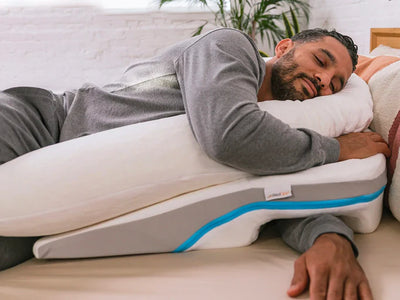
Related Product

Shoulder Relief System
$249.99 USD
Our system has a patented arm pocket that allows your arm to rest comfortably, alleviating pressure on your shoulder and triggering pain.
Best Sleeping Position for Shoulder Impingement
Share
How to Sleep with Shoulder Impingement: Best Sleeping Positions
You don’t know how often you use a body part until it becomes injured. One area of your body you might never take for granted again when it gets hurt is your shoulder. Dealing with shoulder pain can be extremely uncomfortable, especially when figuring out how to sleep with shoulder impingement at night.
Shoulder impingement is when your rotator cuff becomes inflamed, often due to repetitive activities like swimming. If you have a rotator cuff injury, the best sleeping position for shoulder impingement is on your back, as it can relieve potential strain and keep your neck and back aligned.
But this isn’t the only shoulder impingement sleeping tip you should know. To learn more, keep reading below. If you’re looking for a specific answer to a question related to sleeping with shoulder impingement, check out the following links:
What is shoulder impingement syndrome?
Shoulder impingement syndrome occurs when the tendons in your shoulder’s rotator cuff become pinched between the top of your upper arm (the humerus) and the tip of your shoulder (the acromion)(1). Pain and swelling occur when the muscles connected to one end of your shoulder blade don't slide smoothly with the muscles connected to your upper arm on the other side of your shoulder blade. This pain is typically felt when you lift your arm and your rotator cuff tendon rubs on your acromion.

Shoulder impingement syndrome is a relatively common injury. Of all musculoskeletal complaints, shoulder pain is the third most common(2), with 18 to 26% of adults experiencing some form of shoulder pain in their lifetime(3). Shoulder impingement syndrome can be caused by a variety of factors, such as:
- Shoulder joint injuries
- Activities that involve repetitive movements of the arm and shoulder. Think: football, swimming, tennis, and baseball
- Bone spurs that result from wear and tear, leading to irritation of the tissue around the bone
- Aging(1)
If you have shoulder pain while sleeping and one of these causes relates to you, you may suffer from shoulder impingement. This injury can make sleeping difficult because pressure is often applied to your injured shoulder while you sleep, resulting in pain that keeps you awake. Lack of movement while you sleep can also cause fluid to build up, which may leave your shoulder sore in the morning.
Shoulder impingement syndrome isn’t the only injury that can plague your rotator cuff and impact sleep. Other rotator cuff injuries that might cause you pain during the night include:
- Tendinitis
- Tendon tear or strain
- Bursitis
- Overuse
To get an accurate diagnosis, seek help from a health practitioner. In the meantime, research science-backed solutions and tools, like MedCline’s Shoulder Relief System, to help you sleep better in the positions listed below.
Worst Sleeping Positions for Shoulder Impingement or Rotator Cuff Pain
If you have a bruise, you most likely avoid applying pressure on it because it hurts. The same goes for shoulder impingement and rotator cuff injuries. While you may not be able to see a shoulder impingement or rotator cuff injury on the outside, like a bruise, you can certainly feel it inside.
Increased pressure on your shoulder can worsen the pain, which is why certain sleeping positions can cause extra shoulder strain and elevate the pain. Some sleeping positions to avoid if you have shoulder impingement or rotator cuff pain include the following:
- Sleeping on your side - If you’re like most people, you most likely sleep on your side. In fact, roughly 74% of people fall asleep when lying on their side(4). But when you sleep on your side, your body weight adds pressure and can increase shoulder pain. That’s why it’s best to avoid sleeping on the shoulder that’s causing you pain and switch to your back instead.
- Sleeping on your stomach - Stomach sleepers might also find themselves uncomfortable when sleeping with shoulder impingement or a rotator cuff injury. That’s because your shoulders sag forward and apply pressure when you sleep on your stomach, resulting in neck and shoulder pain.

Best sleeping positions for shoulder impingement and rotator cuff pain
Even if you don’t have shoulder impingement, sleeping in the wrong position can make you more prone to shoulder pain, rotator cuff injuries, and tendinitis. In a Danish study, researchers found that 67% of side sleepers experienced shoulder pain on the side they were sleeping on(5).
Knowing the best sleeping positions for shoulder impingement and other shoulder-related injuries can help reduce pain at night. Here are some of the best postures for sleeping with shoulder impingement:
- Sleeping on your back - This is the best sleeping position for shoulder impingement. When you sleep on your back, little to no pressure is placed on your shoulders, neck, or back. This neutral position can provide a pain-free sleeping posture for shoulder pain and help align your spine. For added support, consider placing a small pillow underneath your shoulders to bring your shoulders back and open up your chest.
- Sleeping on your stomach with a pillow - While sleeping on your stomach can increase shoulder impingement pain, using proper support can ease the discomfort. If you need to sleep on your stomach to get a good night’s rest, place a pillow underneath your hips and pelvis. This will help align your lower body with your upper body to prevent your shoulders from sagging. You can also place a rolled-up blanket or towel underneath your shoulders for additional support.
- Sleeping on your side with proper support - Yes, sleeping on your side is the worst position for shoulder impingement, but there are some ways to get around this. For starters, you can sleep on your pain-free shoulder instead. This doesn’t keep you from moving around in your sleep, so try adding proper support, like MedCline’s Shoulder Relief System. It can completely change your side sleeping game. Unlike regular pillows and wedges, our clinically proven sleep system has a patented arm pocket that can be adjusted for optimal support. It also won’t shift around as you sleep, allowing for all-night stability and comfort.

Additional Tips for Reducing Shoulder Pain While Sleeping
Along with sleeping on your back or with added support, here are a few other tips for sleeping with shoulder impingement and rotator cuff pain.
- Take a non-steroidal anti-inflammatory drug such as ibuprofen to decrease pain and swelling.
- Apply ice to your injured shoulder for 15 to 20 minutes before bed to reduce the swelling and inflammation that causes pain.
- Stretch your shoulder before bed when you wake up. Some stretching exercises to help reduce shoulder pain include the following:
- A cross-body stretch where you bring your injured arm across your body and hold for 20 seconds
- A towel stretch where you bring both arms behind your back, hold a towel in both hands, and gently stretch the affected shoulder at a 45-degree angle
- A finger-walk stretch, where you walk your fingers on the arm with the affected shoulder up a wall(6)

Shoulder Impingement Sleeping: Final Thoughts
Lying awake at night because shoulder pain is radiating through your body can be a living nightmare. But there are ways to alleviate this pain when sleeping with shoulder impingement so you can get the rest you deserve.
The best sleeping position for shoulder impingement is on your back, as it takes the pressure off of your shoulder. However, with MedCline’s shoulder relief system, you can comfortably position your arm to reduce shoulder pain and sleep without added pressure. Paired with our tips for reducing shoulder pain while sleeping, you’ll be on your way to a healthy, pain-free shoulder that doesn’t keep you awake at night. Learn more about how the Shoulder Relief System can support your sleep.
[featured-product]
References:
- “Impingement Syndrome of the Shoulder,” Cedars Sinai, https://www.cedars-sinai.org/health-library/diseases-and-conditions/i/impingement-syndrome-of-the-shoulder.html. 15 Jul. 2020.
- Garving, Christina et al. “Impingement Syndrome of the Shoulder.” Deutsches Ärzteblatt Internationalvol. 144,45 (2017): 765-776. https://www.ncbi.nlm.nih.gov/pmc/articles/PMC5729225/, 15 Jul. 2020.
- Linaker, Catherine H, and Karen Walker-Bone. “Shoulder disorders and occupation.” Best practice & research. Clinical rheumatology vol. 29,3 (2015): 405-23. https://www.ncbi.nlm.nih.gov/pmc/articles/PMC4836557/, 15 Jul. 2020.
- Anna’s Linens. “National sleep survey pulls back the covers on how we doze and dream.” PR Newswire, https://www.prnewswire.com/news-releases/national-sleep-survey-pulls-back-the-covers-on-how-we-doze-and-dream-184798691.html, 15 Jul. 2020.
- Kempf, Bo, and Alice Kongsted. “Association between the side of unilateral shoulder pain and preferred sleeping position: a cross-sectional study of 83 Danish patients.” Journal of manipulative and physiological therapeutics vol. 35,5 (2012). https://pubmed.ncbi.nlm.nih.gov/22608285/, 15 Jul. 2020.
- “What to do about rotator cuff tendinitis.” Harvard Medical School, https://www.health.harvard.edu/pain/what-to-do-about-rotator-cuff-tendinitis, 15 Jul. 2020.
Related Product

Shoulder Relief System
$249.99 USD
Our system has a patented arm pocket that allows your arm to rest comfortably, alleviating pressure on your shoulder and triggering pain.


